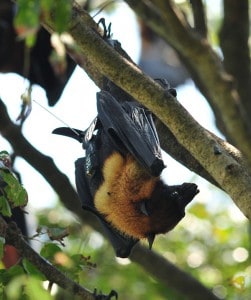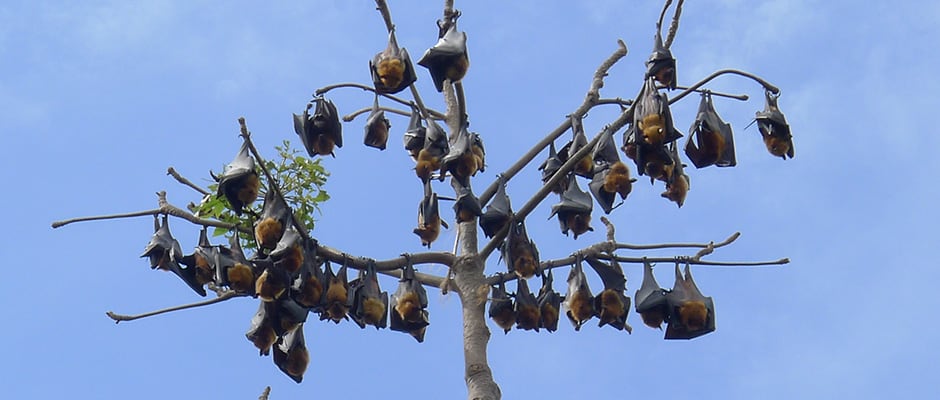Share this article
Using High-Res GPS to Study Thailand’s Flying Foxes
Researchers tracking the movements of flying foxes with high-resolution GPS devices have found that the best way to stop the large bats from getting in conflict with local fruit farmers may be to provide them a more rounded meal.

A flying fox passes by a clock tower near Thailand’s Wat Luang temple. The bats live in relative harmony with the Buddhist monks, making it easier for researchers to study them.
Image Credit: Natalie Weber
It’s essential for people to understand the value that bats bring to the ecosystem and to get them on board with bat conservation efforts, says Natalie Weber, a freelance ecological consultant, an associated scientist with the Max Planck Institute for Ornithology and the lead author of a new study in The Journal of Wildlife Management.
Lyle’s flying fox (Pteropus lylei), listed as a vulnerable species by the International Union for Conservation of Nature’s Red List, faces threats from shrinking habitat due to expansion of human land use and from bush meat hunting. In agricultural areas in Thailand, local fruit farmers see the large flying foxes as a nuisance and sometimes kill the animals to stop them from eating their commercial crops.
But Weber and a number of other researchers from the Max Planck Institute, the United Nation’s Food and Agriculture Organization, and Thai universities wanted to determine what the flying foxes ate exactly, and how they used their environment. They caught a number of flying foxes in two temples east of Bangkok roughly 15 miles apart and equipped the bats with GPS devices. Both colonies comprised around 10,000 animals, with some seasonal fluctuations. Since they live in Buddhist temples alongside monks and are used to humans, Weber said the bats were “quite calm and relaxed” around the researchers, and generally easy to work with.

A flying fox, fitted with a GPS logger, rests on a tree. Researchers tested two ways to attach the GPS devices with the goal that they would eventually fall off the animals. They used glue in some cases and attached a kind of backpack to the bats in others.
Image Credit: Prateep Duengkae
The researchers found that overall the flying foxes had diverse diets of around 34 food plant species, indicating the potential of these bats to disperse seeds and help regenerate vegetation. While the bats did eat fruit from mango and other commercial crops, flying foxes appeared to favor native crops such as certain fig trees over planted fruit trees — even when the fruit farms were more convenient to reach from their temple homes.
“I was really surprised to see the diversity of the diet that the bats consume in this area,” Weber said.
She said that this finding could be used to reduce conflicts between local farmers and flying foxes. For example, if farmers planted more native crops around orchards, the bats may rely less heavily on their fruit alone.
According to Weber, information about flying fox ranges can also help in managing zoonotic diseases. Scientists are examining the role of this and other species of flying foxes in the transmission of the pathogenic nipah virus to humans, and knowledge of the ranges and movement patterns of the species could reveal potential contact zones.
Header Image:
Flying foxes rest on their day roost in Wat Luang temple in Thailand. A new study tracked Lyle’s flying foxes with GPS loggers to find out what kind of food they eat, and how conflicts between local fruit farmers and the bats could potentially be limited.
Image Credit: Natalie Weber








